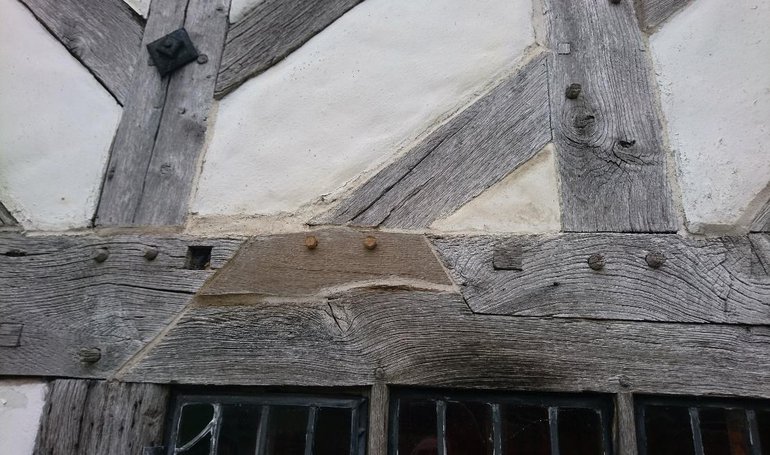Many of our historic buildings are in excess of 400 years old, and in effect still represent the very best in low carbon footprint construction, and continuous material recycling.
Principally constructed from English timber, local stone, lime mortar and bricks, they will have been hand-built from materials available readily locally, and of course with zero-use of heavy machinery.
Our conservation building team use hand tools and methods for much of their work that the original builders would still recognise today. We also source traditional building materials from local suppliers wherever possible and look to reduce transportation distances whenever we can.
If we look at these materials today, they still compare very favourably with their more modern replacements, generally coming out on top in terms of being ultra-low carbon lifecycle, highly sustainable construction materials and methods.

Sustainable Timber
In a progress report to Parliament, the Climate Change Committee (CCC) has once again recommended the UK Government substantially increase the use of timber in construction to help us achieve our net-zero ambitions.
Timber has a relatively small carbon footprint when compared to other building materials. It can also be continually reworked and repaired without the need often to replace large sections of wood.
Most of our historic buildings are constructed using English oak or elm frames, felled in the local area, usually in the year that they were built unless “borrowed” from other dismantled structures nearby.

We work much of this by hand to ensure the finish is similar in appearance to the original craftsmanship, and splice new pieces of timber into areas needing attention rather than replacing whole timbers wherever possible.
Our replacement oak generally comes from England or the north of France from FSC approved suppliers. We will use recycled oak from other buildings where available, as this reduces the mileage involved in procurement as well as providing seasoned timber of a similar age to the original.
Sustainable Lime
Lime provides the “glue” that holds many traditional building materials together, as well as providing a breathable, but water-resistant covering to walls, ceilings and for external render.
Produced at a lower temperature than cement, lime mortar production requires less energy, resulting in 20% less CO2 output. Lime putty also absorbs CO2 in the curing process, and more slowly through the rest of its lifecycle.
Our lime is usually sourced within the UK as this reduces delivery mileage, although during several recent supply chain shortages we have also had to procure this from Northern France. The picture shows Chris from our team lime-plaster coating a section of ceiling in the Birthplace Parlour.
Lime mortar can also be easily recycled unlike cement, along with other building materials bonded with it such as bricks, stone blocks and tiles. It can also be used to make more lime mortar, or even to improved soil quality.
Lime mortar is therefore a truly eco-logical, versatile and environmentally friendly building material in its production, its use and afterlife.
Sustainable Brick
Clay bricks generally have a better life expectancy than concrete. Whilst concrete blocks for example can last up to 100 years, clay bricks can remain viable for 1000 years or more.

The thermal mass of the bricks is also high, so they absorb heat during the day and then release it at night.
This makes structures cooler during the day and warmer at night, resulting in lower energy costs. They are also made from fully recyclable materials.
Sustainable Recycling
When it finally breaks down or is damaged, lime mortar is completely recyclable. This also makes recycling bricks, stone, and other natural hard materials bonded with it so much easier to reuse, as opposed to concrete or cement which cannot be recycled without the aid of some significantly energy-hungry machinery.
Old lime mortar can itself be easily crushed and recycled for use as aggregate in new lime mortars. This can be done over and over again, giving lime mortar a theoretically limitless lifecycle.
Many of our buildings when originally assembled, used timber, stone and sometimes brick reused from other buildings in the area. All the material used to construct our own historic houses for example, could quickly and easily be reused to build or repair another.
In Estates, we often use material from other buildings to repair our own, perpetuating the principle of continuous recycling whenever possible.
When calculating the lifetime cost and environmental impact of any building, the amount of building material destined for landfill in many modern construction or refurbishment projects cannot be ignored.
The materials we use in heritage building conservation are normally completely natural, and as such can be used and reused again. Lime, stone, brick, glass and tile used to repair our historic buildings may well have been ‘pre-owned’ many times over during the lifecycle of the material, thereby keeping it out of landfill in theory pretty much forever!
To find out more about our work to become net zero in our carbon emissions by 2030 visit our Sustainable Shakespeare page.
